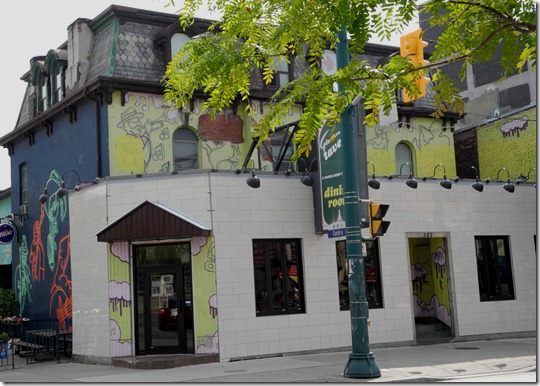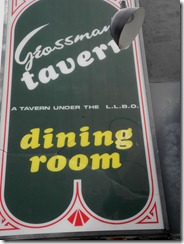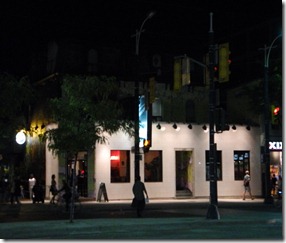Some may question my sanity when I suggest that the building that houses Grossman’s Tavern on Spadina is an architectural gem. I might receive more agreement if I suggested that it is a place to imbibe a little liquid refreshment on a hot summer day or hide from the winter’s chill with a glass of anti-freeze beer. I won’t argue the validity of either opinion, and I am accustomed to having my sanity questioned. However, the next time you stroll along Spadina Avenue, pause for a moment and carefully examine Grossman’s Tavern. Behind the rather plain addition erected across the front of the premises, is an 1880s Second Empire house that at one time contained the home and office of a medical doctor. It is one of only three houses that remain from the days when Spadina was a residential street, many of the homes along the wide avenue belonging to the elite of the city.
The decade before the house was built, the name Spadina referred to the section of the street from Queen Street to Bloor Street. This was the 1870s, and apart from the tavern of Robert Brown on the northeast corner of Queen and Spadina, there was only one house on Spadina north of Phoebe Street. Even in the year 1880, the section of Spadina north of Queen, on the east side, remained vacant. The large Second Empire home that was later to house Grossman’s Tavern, was built in 1884. It was constructed for Dr. John Ferguson M. D.
The three-storey home was impressive, as befitting a medical practitioner. Its Mansard roof and generous proportions dominated southeast the corner of Cecil Street and Spadina Avenue. Dr. Ferguson remained in residence until 1890, when Dr. Henry Hunt took over the practice. In 1906, Edward Rutherford lived on the premises. He earned his living as a supplier of medicines and toiletries, his shop being at 398 Spadina. In 1907, the house was occupied by Dr. Malcolm Cameron. He remained the local doctor until 1919, when Dr. Murray Robertson moved in. In 1923, he was replaced by Dr. Frederick R. Hayes. During a few of the depression years, Hayes shared the premises with Dr. Woolfson. In 1935, it became the private residence of Mary Koski, and in 1938, that of Rama Walno.
In 1952, it became Grossman’s Cafeteria, operated by Louis Grossman, telephone number EMpire 6-8495. Rose Grossman lived in the south portion of the building. In 1959, the City of Toronto Directory of that year lists both 377 and 379 Spadina as being Grossman’s Tavern.
To view the Home Page for this blog: https://tayloronhistory.com/
Links to other posts about the history of Toronto and its buildings:
https://tayloronhistory.com/2013/10/08/links-to-historic-architecture-of-torontotayloronhistory-com/
Links to posts about Toronto’s movie houses—past and present.
https://tayloronhistory.com/2013/10/09/links-to-toronto-old-movie-housestayloronhistory-com/
Recent publication entitled “Toronto’s Theatres and the Golden Age of the Silver Screen,” by the author of this blog. The publication explores 50 of Toronto’s old theatres and contains over 80 archival photographs of the facades, marquees and interiors of the theatres. It also relates anecdotes and stories from those who experienced these grand old movie houses.
To place an order for this book:
Theatres Included in the Book
Chapter One – The Early Years—Nickelodeons and the First Theatres in Toronto
Theatorium (Red Mill) Theatre—Toronto’s First Movie Experience and First Permanent Movie Theatre, Auditorium (Avenue, PIckford), Colonial Theatre (the Bay), thePhotodome, Revue Theatre, Picture Palace (Royal George), Big Nickel (National, Rio), Madison Theatre (Midtown, Capri, Eden, Bloor Cinema, Bloor Street Hot Docs), Theatre Without a Name (Pastime, Prince Edward, Fox)
Chapter Two – The Great Movie Palaces – The End of the Nickelodeons
Loew’s Yonge Street (Elgin/Winter Garden), Shea’s Hippodrome, The Allen (Tivoli), Pantages (Imperial, Imperial Six, Ed Mirvish), Loew’s Uptown
Chapter Three – Smaller Theatres in the pre-1920s and 1920s
Oakwood, Broadway, Carlton on Parliament Street, Victory on Yonge Street (Embassy, Astor, Showcase, Federal, New Yorker, Panasonic), Allan’s Danforth (Century, Titania, Music Hall), Parkdale, Alhambra (Baronet, Eve), St. Clair, Standard (Strand, Victory, Golden Harvest), Palace, Bedford (Park), Hudson (Mount Pleasant), Belsize (Crest, Regent), Runnymede
Chapter Four – Theatres During the 1930s, the Great Depression
Grant ,Hollywood, Oriole (Cinema, International Cinema), Eglinton, Casino, Radio City, Paramount, Scarboro, Paradise (Eve’s Paradise), State (Bloordale), Colony, Bellevue (Lux, Elektra, Lido), Kingsway, Pylon (Royal, Golden Princess), Metro
Chapter Five – Theatres in the 1940s – The Second World War and the Post-War Years
University, Odeon Fairlawn, Vaughan, Odeon Danforth, Glendale, Odeon Hyland, Nortown, Willow, Downtown, Odeon Carlton, Donlands, Biltmore, Odeon Humber, Town Cinema
Chapter Six – The 1950s Theatres
Savoy (Coronet), Westwood
Chapter Seven – Cineplex and Multi-screen Complexes
Cineplex Eaton Centre, Cineplex Odeon Varsity, Scotiabank Cineplex, Dundas Square Cineplex, The Bell Lightbox (TIFF)



![cid_E474E4F9-11FC-42C9-AAAD-1B66D852[2] cid_E474E4F9-11FC-42C9-AAAD-1B66D852[2]](https://tayloronhistory.com/wp-content/uploads/2014/10/cid_e474e4f9-11fc-42c9-aaad-1b66d8522_thumb1.jpg)